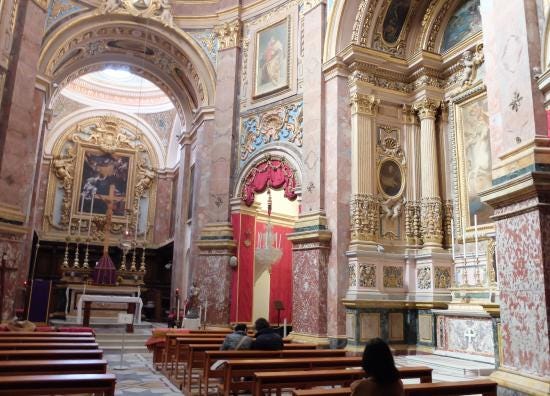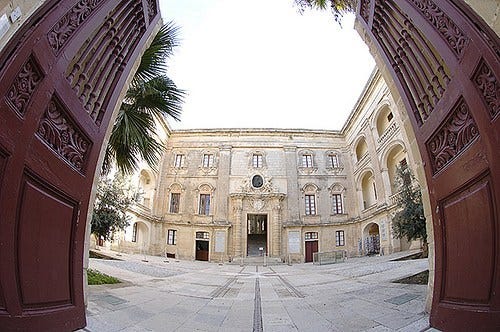5 Amazing Places To Visit In Mdina Malta
Entirely surrounded by ancient ramparts, Mdina Malta is a magical place where the modern age seems far away. This picturesque, medieval walled city has a special enchantment, found in the enclosed labyrinth of narrow, twisting streets and the old sandstone buildings that glow a rosy hue in the sunlight. Quiet lanes lead to shaded courtyards, and magnificent palaces are hidden behind large wooden doorways. Mdina (also known as Città Vecchia) is a popular day-trip destination from Valletta, but by evening, the town lives up to its reputation as the “Silent City.” Mdina overlooks a tranquil countryside of rolling hills, and borders Rabat outside its western ramparts. In contrast to the more touristy Mdina, Rabat is a real working city with several interesting historical attractions, all within walking distance from Mdina.
Mdina Citadel

As a typical walled city, Mdina’s immense ancient ramparts give the town a fairy-tale charm. Enclosing a little warren of narrow lanes and stately old buildings, the town’s fortifications date back to the medieval period when the city was ruled by the Arabs and Normans. The most obvious influence of the Arab occupation is Mdina’s labyrinthine street plan. The winding streets and pedestrian alleyways are characteristic of Islamic urban design in the Maghreb (Morocco, Algeria, and Tunisia) during the Middle Ages. The town’s Baroque Main Gate was built in 1724. The escutcheon bears a coat of arms, while statues of growling lions stand proudly in the front of the gate. Once visitors enter this doorway by foot, they leave the 21st century behind. Only residents’ cars are allowed inside. Within Mdina’s ramparts, it feels like an escape to a bygone world. Graceful squares and quiet streets are lined with elegant aristocratic palaces and ornate Baroque churches. Street signs are scripted on porcelain plaques. The bastions of the ramparts, including the Saint John’s Bastion and Saint Martin’s Bastion, provide excellent viewpoints of the idyllic countryside surrounding Mdina. But the atmosphere within the ramparts is even more enchanting. To discover the romantic old-world ambience within Mdina’s ramparts, it’s recommended to take a guided walking tour. On the two-hour Mdina Private Walking Tour, a guide leads tourists through Mdina’s maze of winding streets, strolling past the city’s must-see historical landmarks, while providing interesting commentary along the way.
Cathedral of Saint Paul

This splendid Baroque cathedral was designed by Lorenzo Gafà with a handsome facade featuring Corinthian columns. The bright and spacious interior has an inspiring dome that allows light to flood into the sanctuary. The cathedral’s opulent decor features marble inlay floors, gilded detailing, pink marble columns, and breathtaking ceiling paintings.
Wonderful treasures of art are displayed throughout the cathedral’s various chapels. The most prized possession is the 14th-century Byzantine icon of the Madonna in the Chapel of the Sacrament, surrounded by a bejeweled frame in front of a dazzling altarpiece.
Palazzo Falson

The second oldest building in Mdina, this magnificent 13th-century palazzo exemplifies Sicilian-Norman style. During the Middle Ages, the palace was home to Maltese nobles. It is now a museum open to the public. Unusual among historic palaces, the Palazzo Falson displays the original decor of Oriental rugs, antique furniture, and fine paintings. The library contains more than 4,500 books, and the kitchen displays the old cooking equipment. Each of the rooms on display is a treasure trove of art works.
Highlights of the palace’s art collection include 17th-century paintings by Sir Anthony Van Dyck; Nicolas Poussin; Bartolomé Esteban Murillo; and Mattia Preti, the most famous painter of Malta. There is also an impressive assortment of jewelry, hand-painted Brisé fans, and antiquities such as ancient Roman coins. One of the most prized possessions of the Palazzo Falson is the Alof de Wignacourt Medal dating to 1607, a rare medal depicting the Grand Master.
Carmelite Priory

Hidden behind an elegant Baroque facade is the spiritual retreat of the Carmelite Priory, one of the most important religious buildings in Mdina. Built in the 17th century, the beautifully renovated Carmelite Priory is still a functioning monastery run by the Order of the Brothers of the Most Blessed Virgin Mary of Mount Carmel and is the only priory in Malta open to the public. Visitors may participate in the priory’s daily prayers, Mass, and meditation services or take a guided tour.
The priory features a refectory, where monks take their communal meals, and a typical monastic cloister centered around a tranquil courtyard. A highlight of the priory, the Carmelite Church is considered one of the most important Maltese Baroque churches. Visitors can admire the church’s exquisite frescoes in the dome, as well as exceptional paintings by renowned artists including Giuseppe Calì and Mattia Preti.
Palazzo Vilhena

Mdina’s Natural History Museum is housed within the former Magisterial Palace of Justice, an impressive 18th-century building. The palace was designed in Parisian Baroque style for the Grand Master Antonio Manoel de Vilhena. The museum has extensive Geology and Paleontology collections.
Other exhibits display the natural habitats of Maltese birds, fish, and mammals. Special sections are dedicated to Malta’s national bird, the blue rock thrush (Il-Merill) and national plant (Widnet il-Bahar). The museum is also worth visiting just to see the gorgeous interior of the Palazzo Vilhena.
Plan your vacation to Mdina Malta on XcelTrip to make memories that last a lifetime. If you like our content, then follow us on Instagram.



Comments
Post a Comment